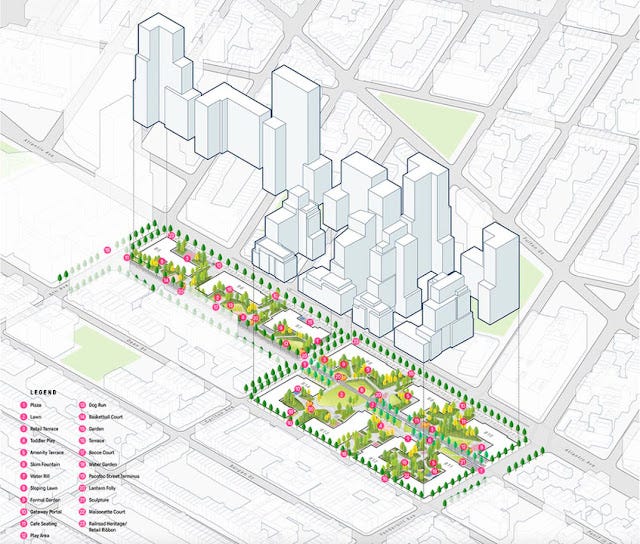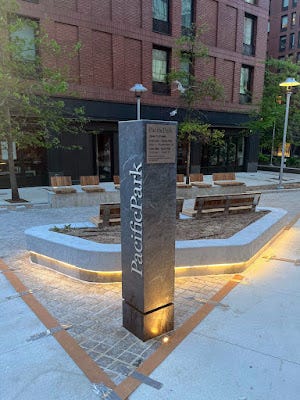Will "Pacific Park" Be Renamed? Housing Surge Would Increase Open Space Deficit
Back to "Atlantic Yards"? Nah. "Another ocean"? Nope. How about "Brooklyn Central"? You read it here first.
Let me predict: Pacific Park Brooklyn, formerly Atlantic Yards, will be renamed.
I have no inside information, and I wouldn't bet my last dollar, but if and when an expected new joint venture takes over, it's an obvious move.
Think about it. Forest City Ratner announced Atlantic Yards in December 2003. New majority owner Greenland USA renamed it Pacific Park in August 2014, ten years and eight months later.

("Atlantic Yards was always a working title," Forest City executive MaryAnne Gilmartin dubiously claimed.)
Now, ten years and two months later, Greenland’s on its way out, at least as majority owner. The Related Companies is expected to be part of a joint venture with the U.S. Immigration Fund and Fortress Investment Group.
Related is still negotiating with Empire State Development (ESD), the state authority that oversees/shepherds the project. It’s a good bet they’ll seek to supersize the project, as the current master developer Greenland USA proposed last year, to make it economically viable.

Why should they keep an tainted name, attached to a now-suspended website?
This is small data point, but, in its lobbying report to state regulators, Related stated that the subject was Atlantic Yards, not Pacific Park. So either they’re not sold on the new name or, like so many, they default to the original.
More housing, less "park"
The distinct possibility, as I wrote, that a new plan might deliver nearly 2,700 more apartments and nearly 5,750 more residents than originally predicted puts Greenland's 2014 name change in an ever more ironic--dare I say cynical--light.
After all, the amount of open space, expressed on a per capita basis, might go down, even if there's an incremental increase beyond eight acres.
"Pacific Park"?
Greenland's 2014 announcement stated, "Like other great urban public spaces, the new park will serve as a centerpiece for the development as well as a destination for people from surrounding communities and throughout the city."
Well, not exactly. First, only 3 of 8 acres have been completed of the privately managed, publicly accessible open space. It may be park-like, but it’s not actually a park, especially when the Pacific Park Conservancy is a phantom.
Also, however nice the finished "park" might be, it will struggle to serve the growing population, not to mention neighbors. Indeed, the dog run next to the West Tower of 595 Dean is already overcrowded and busy before and after hours.
No wonder Greenland, as I reported, redesigned two towers (B6 and B7) to add incremental open space. They even asked ESD officials to help them acquire part of adjacent Pacific Street, between Sixth and Carlton avenues, for additional open space.
Enter Pacific Park
Why call it “Pacific Park”?
Greenland, the U.S. arm of a Shanghai-based parent company, surely aimed to dissociate the project from its controversial past. Erasing history didn't really work, since many people still use Atlantic Yards or the hybrid Atlantic Yards/Pacific Park.
After all, ESD officially calls it the Atlantic Yards Land Use Improvement and Civic Project, with the Atlantic Yards Community Development Corporation (AY CDC) “created in November 2014 to oversee and monitor” it.
It was cynical, as I wrote in 2014, to focus on open space yet unbuilt and years away. Also, it was distracting to reference narrow Pacific Street rather than wider Atlantic Avenue.
What next?
Why another name change? A new developer might want not only to reboot the project but also avoid focusing on the “park,” which still would be years away and might ultimately seem as much deficit as asset
.Might the next developer revert to “Atlantic Yards”? Well, Related did build--and is still building--Hudson Yards. Still, I suspect there’s too much stigma.
Might the project be renamed "after yet another ocean,” as New York Magazine's Justin Davidson once playfully predicted? Nope, too fanciful.
Why not “Brooklyn Central”?
Or perhaps--and I'm just spitballing here--Related or another developer might choose a bland, non-oceanic name, which supplies both geographic gravity and distance from the failed stewardship of Forest City and Greenland.
How about "Brooklyn Central"? (They might have to buy the name of a now-closed Park Slope pizzeria.) Have I just saved them a pretty penny on a branding consultancy?
Let’s face it: the project’s best selling point is “Brooklyn” and its central location near transit and adjacent prime neighborhoods.
After all, Forest City's Downtown Brooklyn office complex MetroTech was changed by new owner Brookfield to the bland Brooklyn Commons, focusing on the open space.
The “park” has hardly been the focus of the newest towers near the Barclays Center. They’re branded Plank Road (a whimsical nod to the past) and Brooklyn Crossing (bland but legit). It makes little sense to tout the larger project, especially since there’s no open space yet nearby.
A block to the east, columns on Dean Street at the entrance to the existing open space do announce Pacific Park and the phantom Conservancy. Such signage could be tweaked.
Open space goals not met
One argument for keeping Pacific Park: the six towers at the railyard would deliver five more acres of open space, once an expensive platform is built. Then again, that could take more than ten years, past the current “outside date” of 2035, at least if project contracts are renegotiated, as proposed.
However, that still wouldn’t resolve the problem: the amount of open space is inadequate for the project’s residents, much less the surrounding area.

See this Aug. 17, 2006 coverage by Anne Schwartz in Gotham Gazette. While it assessed a previous configuration, with only 7 acres of open space and more than 6,800 apartments (as opposed to 8 acres and, for now, 6,430 apartments), it contrasts Atlantic Yards with a project like Battery Park City, with far more open space for its residents.
Lagging, but never mind
An official analysis was somber. ESD's June 2014 Final Supplemental Environmental Impact Statement (SEIS), Chapter 4c, Operational Open Space, concluded that, while the proposed amount of open space lagged city standards, it didn't matter.
The Department of City Planning seeks 2.5 acres per 1,000 residents, including .5 acres of passive space and 2 acres of active space. The citywide median ratio is less: 1.5 acres per 1,000 residents.
"Because these ratios may not be attainable for all areas of the city," the document states,"they are considered benchmarks for comparison rather than policy or thresholds for determining impacts."
Thus, a projected ratio of just .362 acres per 1,000 residents, in the ½-mile residential study area around Atlantic Yards, was not considered a deficit.
Is that projection still accurate? Since 2014, new buildings have been approved just east of the project, around Atlantic Avenue, adding to the population.
They didn’t add incremental public open space but added to pressures on existing open space. Hence the push for the broader Atlantic Avenue Mixed-Use Plan (AAMUP), which takes a more holistic approach to the area.
Beyond that, increasing the number of apartments in Atlantic Yards/Pacific Park would further change the math.
Other parks help?
ESD likely would wave that away again. According to the guiding CEQR Technical Manual, "a project may result in significant adverse impacts to open space" if the project reduced open space ratios by more than 5 percent in an area currently below the city’s median open space ratio.
However, in areas said to be well-served by open space, like this one--because of the presence of Prospect Park and Fort Greene Park--"a greater change in the open space ratio may be tolerated."
How well it's served is debatable. Atlantic Yards/Pacific Park is pretty big, so the closest building to Fort Greene Park is a 12-minute walk (per Google), while the farthest is 17 minutes, all requiring people to cross wide, busy Atlantic Avenue.
The closest building to Prospect Park is 15 minutes away, and the farthest 20 minutes, though a development at Site 5 would be an even longer walk. So neither park is a simple stroll.
"Substantial" increase?
A closer look at the document shows a substantial amount of spin, suggesting the full buildout—as expected in 2014—”would result in a substantial increase in the ratio of acres of total and passive open space per 1,000 residents, but the total, active, and passive open space ratios in the residential study area would remain below city guideline levels.”
What’s "substantial"? A 17.5% increase, to 0.362 acres per 1,000 residents, compared with 0.308 acres if the project weren’t completed.
That’s still way below city guidelines.
"While the total, passive, and active open space ratios would be below city guidelines in the Future With Phase II, the overall effect of Phase II of the Project on the availability of open space resources in the study area would be beneficial," the document concludes.
A new name?
If the project gets revamped with, as I estimated, 2,686 more apartments and 5,748 people, it gets harder to support the conclusion that future open space redeems the project.
So, along with the reboot any new developer has to consider, the “park” becomes less of a selling point.
That’s why I wouldn’t be surprised by the end of "Pacific Park" and the advent of “Brooklyn Central” or a similarly framed name. A lot of us would still probably call it “Atlantic Yards" or a hybrid “Atlantic Yards/New Name.”










